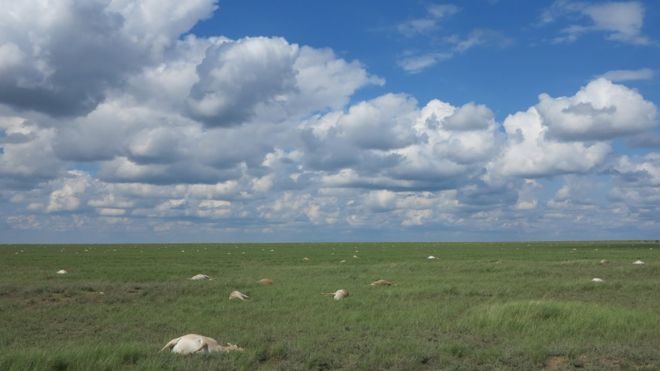
The May 2015 deaths were caused by hemorrhagic septicemia triggered by a bacteria known as Pasteurella multocida Type B, which dwells in the respiratory tract of the animals, according to a study on the event.
"The animals were in a sort of foggy soup, and it looks like the bacteria naturally occupying the tonsils were woken up by this environmental factor," Royal Veterinary College professor of wildlife health and emerging disease Richard Kock told The Washington Post.
Kock told NPR that the bacteria, found in the tonsils of the animals, responded to the change in atmosphere by growing.
The researchers compared the incident to two separate die-off events in 1981 and 1988 that were likely due to hemorrhagic septicemia caused by changes in humidity and temperature.
"The fact that P. multocida infection in saigas appears strongly linked to high humidity and temperature is of concern going forward, given that a climate change-induced increase in temperature is projected for the region over the short to medium term and evidence for recent change is strong," wrote the scientists.
Some 30,000 of the animals managed to survive this recent event, and Kock suspects it is because they were not in the same "climate envelope" as the others, NPR reports. Some male saiga moved further north where there was less humidity, while some female animals moved to remote areas in small groups.
The animals have since recovered and resumed breeding, but it's unclear whether they could survive a second event.
"If we get a similar event, and all the animals are within a sort of weather envelope, it could be total extinction. It could happen in a week," said Kock.
"Given the saiga population's vulnerability to mass mortality and the likely exacerbation of climate-related and environmental stressors in the future, management of risks to population viability such as poaching and viral livestock disease is urgently needed, as well as robust ongoing veterinary surveillance," wrote the scientists. "A multidisciplinary approach is needed to research mass mortality events under rapid environmental change."
The World Wildlife Fund lists the animals as critically endangered.



Comment: Strangely enough, no one knows for sure why flu viruses appear in winter. Some say that viruses thrive in low humidity because they remain suspended in the air longer, but humidity can be very high in wintertime in many places. Maybe these bacteria and virii are in our bodies all the time and only activate during certain atmospheric conditions. Maybe some bugs need a 'key' to turn them on? Like some other virus or something in the atmosphere?
See also: Sixth Extinction continues: Mass deaths of Saiga antelope in Kazakhstan caused by bacteria